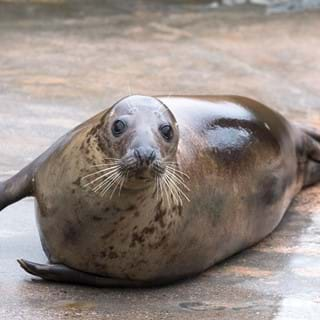Grey Seals
Grey Seals
Meet Sheba, Yulelogs, Marlin and many more of our Grey Seal residents and hear their rescue stories. Learn all about their characters and why they now have a permanent home here at the Sanctuary. Discover how Grey Seals survive in the wild and how the team at the Cornish Seal Sanctuary rescue over 70 injured or abandoned Grey Seals every year from around the Cornish Coast.
Did you know?
•The scientific name for the Grey seal is Halichoerus grypus which means ‘hooked-nose sea-pig’!
• Grey seals will perform behaviours known as ‘bottling’ and ‘logging’. This is when they bob around vertically or horizontally in the water with just their head or back above the surface of the water. This is how they rest at sea while out foraging for days at a time.
• Grey seals are amazing divers and can stay under water for up to 40 - 45 minutes at a time! Unlike humans however, when grey seals dive they don’t take a big breath of air, they actually breath out most of the air in their lungs so it doesn’t make them float. Instead, they have specially adapted circulation and respiratory systems that allow them to hold lots of oxygen in their blood and muscles!
• Scent is really important to grey seals. They will sometimes greet each other by sniffing and mothers also identify their pups by smelling them. They are also one of the few animals that are able to smell underwater!
• The fur coat of grey seals is different patterns for males and females, males are darker and a more solid colour all over, whereas females have a steely grey coloured back and a mottled creamy colour belly.
•Each grey seal has a unique pattern in its fur which remains the same for their entire life.
Seal Rescue, Rehabilitation and Release
We rescue over 70 injured Seal pups from local coastal waters each year and bring them to our Seal Hospital to undergo a rehabilitation programme. It costs over £2,000 to rehabilitate just one seal pup and get them fit for their release back into the wild, so we are extremely grateful our guests continue to support the work we do. Grey Seal pup season is from September - March, this is when our hospital and nursery pools are the busiest!
During the rehabilitation process, the first place our rescued pups go to is our Seal Hospital. They will be put in our isolation pens, which allows the team to be able to closely monitor progress, give medication and also feed the pup. When they are feeling brighter, the pup will move to the main hospital pens, which has the facility to be filled with water when the pup is ready for swimming.
Our guests are able to visit the hospital to see how our patients are doing and get a real behind the scenes experience of a working seal rescue hospital.
Once the pup is free from infection and a healthy weight, we then introduce them to the Nursery Pools, where they are often put in with another pup, which allows them to learn how to behave around other seals. After this, they are introduced into our main Seal Pool to learn how to interact with adult seals as they would in the wild, and how to fight for their fish - all the skills they need to know for when they get released.
Once the animal care team are satisfied the pup is at a healthy weight and ready, the Sanctuary releases them back into the wild.

